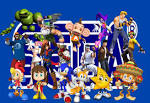
Readers of this blog may have caught a post I wrote around a year ago about the worst video game controller buttons ever made. I fully intended to follow that up with a post about the greatest video game controller buttons ever, but my ever-frequent sidetracks came along and kept me from doing so. But since it was a great idea, I knew I would have to get around to writing on the subject eventually, and so here it is: The long-awaited follow-up. Every gamer knows that some gaming console controllers are better than others, but there a lot of individual controller buttons which are better than others. Some are excellent for their quality and ease of use, others for their innovations, and still others are good for the way they commonly function. But which ones are the best of the best of the best? Well, keep right on reading, because I’ve come up with an inarguable, bulletproof list of the best video game controller buttons of all time. I wrote it up on my napkin during break!
Yes, you can blame Kotaku for inspiring the original idea. But Kotaku doesn’t do descriptions or explanations, and I do, so there!
10 – A Button
Gamecube Controller
Better known as The Big Green Button, the one thing the Gamecube controller managed to get right was the ginormous A Button. Standing out among a formation of oddly spaced and oddly shaped controller buttons, Nintendo’s signaling of the phrase “PRESS ME!!!” was placed front and center, larger than any of the other buttons on the damned thing, bright green and basically impossible to miss. It might as well have been a giant neon sign. Just sitting there, the A Button knew it was the lord and master of everything it surveyed. Whatever game you happened to be playing on the Gamecube, you knew that whatever function The Big Green Button performed was going to end up being hella important, and so you started plotting your gaming style and strategy accordingly. In a way, that made the Gamecube controller’s A Button an evolutionary step up from one of the legendary video game controller buttons…
9 – Button
Atari 2600 Controller
Yes, this is a posterity pick, but you’re kidding yourself if you don’t think it deserves a spot on this list. See, you have to remember that video games are like any other entertainment medium – they evolve, and a lot of things that were once innovations either become better versions of themselves or get junked. Back in the days of gaming yore, no one thought that video games were ever going to need more than one button, so yes, this sucker ended up running its course. But what a course it was! Sitting there alongside a joystick, you always knew where it was and what it did because it was the only action button the 2600 used. It’s the only dash of any real color on the controller. It made Pitfall Harry jump, it made the thing in Space Invaders fire, it… Well, it performed countless different functions in just as many video games. And unlike the finicky joystick standing there next to it, it never particularly cared about the position it was in in relation to the gamer, because it always performed the same way whether it was upside-down or not!
8 – Start
Genesis Controller
This is a weird selection, mainly because the Genesis controller’s version of the Start button eventually turned into such a wild card. As most people who know anything about video games are aware, the Genesis controller did something unprecedented: It wiped out the common stock button known as Select and replaced it with a third action button. At first, this looked like overkill. Then it looked like foresight. It eventually started to look backwards after Nintendo placed four action buttons and two shoulder buttons on the Super NES controller. That last one started to cripple the Genesis when Sega decided that it wasn’t going to start including six-button controllers in its packaging. Not everyone bought the six-button, and those who decided not to but loved fighting games were treated to a myriad of weird control substitutions which often utilized the Start button. In one game, it could be the turbo button. In another, it could be block. And in others, it switched between punches and kicks. The caveat was that there was no way to pause a game, but a button as useful and quirky as the Genesis Start button wasn’t something we saw everyday.
7 – D-pad Right
Most 16-bit Video Game Controllers
Well, what other direction would you go in?
6 – Z Trigger
Nintendo 64 Controller
For all the bad-mouthing we do about it, the Nintendo 64 controller was a stroke of genius in a handful of different ways. The Z Trigger is one of the coolest little innovations I’ve ever seen on a controller. Used in tandem with the analog stick, it brought a bit of ease to first-person shooter players because it was now possible to aim and fire using the same hand. Yes, the usual griping came out of PC gamers, but the Z Trigger introduced a natural ease to shooters which hadn’t been felt since the point-and-press days of Space Invaders. If you weren’t much for first-person shooters, well, you got stuck using the Z Trigger anyway. As I wrote in my piece about the worst controller buttons ever, the Nintendo 64 controller was bogged down by the fact that no one ever programmed anything into the d-pad or L button. The entire left side of the controller was useless. So when a function needed to get placed into a shoulder button, it was the Z Trigger that got the outsourced function on the Nintendo 64 version. What we have here is a novelty trigger with more versatility than a trigger is usually allowed.
5 – Analog Stick
Nintendo 64 Controller
And hey, speaking of the Nintendo 64’s analog stick, does anybody remember how much everybody HATED the thing when it first came out? The only reason we had trouble adjusting to it was because we never HAD to adjust to something so radical before. Even the Sony Playstation, which was launched around the same time and led by a prevalence of 3D games, used the basic d-pad. But the analog stick turned out to be an instance where’s Nintendo’s attempt to force gaming to evolve was right on point. Yes, everyone is still so in love with the original d-pad that all the major console makers are forcing them onto their controllers to this very day. But as a form of basic movement, the d-pad is a two-dimensional way of moving for a two-dimensional time in video gaming. When games jumped to 3D, Nintendo saw that gamers would need a form of uninhibited movement in 360 degrees. It saw that we were going to need our games to read more minute movements which would have to be read in more efficient ways than light, gentle taps on the d-pad. Now here we are over 20 years after the fact, and no hardware maker is crazy enough to try to launch a new console without this standard form of movement.
4 – L2 and R2
Playstation 2 Controller
Yes, I know everyone remains in love with the pill known as the Super NES controller. And yes, it WAS important – it included more action buttons than any controller ever seen at that point and introduced the first two shoulder buttons. Unfortunately, the thing was small and uncomfortable, and I hated the thing so much that I passed on the Super NES for a Genesis. When Sony introduced the first Playstation, the pistol grip put my deformed arm at ease, so it rescued my ability to game. But it wasn’t until the Dual Shock 2 came out that Sony saw it fit to extend and taper the bottom two shoulder buttons, making them easier to grasp and get our fingers around in way that was more natural than anything we had seen before. Although L2 and R2 were originally done as novelties that only made it easier to fit more functions into a single controller, the Playstation 2 is where they started to take on a new life of their own. The use of shoulder buttons as basic action buttons started with the Dual Shock 2, and a console generation later, Sony started spring-loading the buttons to allow their greater involvement in video games.
3 – L Trigger and R Trigger
Dreamcast Controller
Concluding the trigger portion of this list is the breakthrough enhancement that enabled designers to see the potential of triggers on controllers. Yes, the Nintendo 64 was the original, but the Dreamcast spring-loaded the things and placed them properly underneath the controller, transforming the difficult shoulder buttons into practical devices we could use without having to remind ourselves that they were there. Microsoft liked them so much that they nicked them straight for the original Xbox controller, creating the iconic versions of the L and R Triggers gamers have all come to know and love.
2 – X and Y Buttons
Super NES Controller
After Sega added a third action button to the Genesis controller, Nintendo realized it would have to go big. So it created a controller for its new flagship console with four action buttons and two shoulder buttons. Not only did that force Sega to create more evolved controllers to add to the Genesis, but how many more controllers had a button C? Even the Dreamcast used the X and Y axis layout.
1 – B Button
NES Controller
Okay, you can make a powerful argument that the A button belongs in this spot, and I’ll understand. A made Mario jump and Link swing his sword, after all. B was slightly more innocuous in Nintendo’s primary mascot series because Mario mostly ran with it. But when you make that argument, you’re denying Mario his ability to throw fireballs, Link the ability to shoot his bow and arrow, Samus the ability to shoot anything, and Kirby the ability to suck up his enemies. My qualm with A here is that so much of its function revolved around jumping. It was B that continued what Atari started with the 2600 controller, but it pulled off the trick of doing that while being an additional button which let gamers play with accessories and power-ups. B was the sort of button that shined bright whenever its time came, but which knew that it had to take a backseat at other times. It was B that eventually caused video game controllers to expand the way they did, inviting the other action buttons to show up at the party and bring along unique personalities of their own. B was the button that was at ease playing either the leader or the sidekick. Its position on many of today’s hand-engulfing controllers still enables it to play both of those roles with ease. And all of it started when Nintendo promoted it to its first big boy console.





